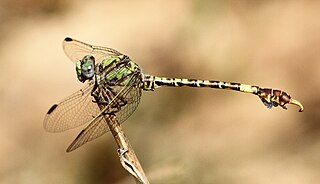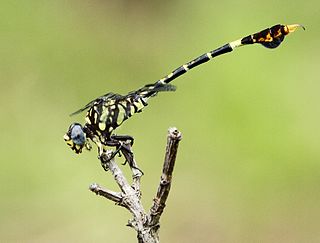
The shoal bass is a species of freshwater fish in the sunfish family (Centrarchidae) of order Perciformes. One of the black basses, it is native to waters in Florida and Georgia. It is also occasionally found in rivers and streams of East Alabama where it has been declared an endangered species and cannot legally be kept if caught by fishermen. Of typical size for a black bass, M. cataractae reaches a maximum recorded length of 24 inches (61 cm) and a maximum published weight of 8 pounds, 12 ounces.

The longnose dace is a freshwater minnow native to North America. Rhinicthys means snout fish and cataractae means of the cataract. Longnose dace are small, typically less than 100 mm and characterized by their fleshy snout that protrudes past the mouth. They are well adapted for living on the bottom of fast-flowing streams among stones. Longnose dace eat algae and aquatic insects and are important forage minnows for larger predatory fish.
Psiadia cataractae is a species of flowering plant in the family Asteraceae. It is found only in Mauritius. Its natural habitat is subtropical or tropical dry forests.

The Angolan cave chat is a small passerine bird in the Old World flycatcher family Muscicapidae. It used to be the sole member of the monotypic genus Xenocopsychus but was moved to Cossypha based on the results of a molecular phylogenetic study published in 2010. It occurs locally from western Angola to marginally south of the Kunene River in northern Namibia. Its natural habitat is rocky places in moist to dry savanna. It was previously described as being Near threatened, but has since been downgraded to Least concerned.
Paragomphus alluaudi is a species of dragonfly in the family Gomphidae. It is found in Angola, Ethiopia, Kenya, and Tanzania. Its natural habitats are subtropical or tropical dry shrubland, subtropical or tropical moist shrubland, and rivers. It is threatened by habitat loss.

Paragomphus is a genus of dragonfly in the family Gomphidae. They are commonly known as Hooktails.
Paragomphus bredoi is a species of dragonfly in the family Gomphidae. It is found in the Democratic Republic of the Congo, Malawi, and possibly Uganda. Its natural habitat is subtropical or tropical moist lowland forests. Although its status is of "Least Concern", it is still threatened by habitat destruction.

Paragomphus cognatus (Rock Hooktail) is a species of dragonfly in the family Gomphidae.

Paragomphus elpidius, the corkscrew hooktail, is a species of dragonfly in the family Gomphidae. It is found in Botswana, the Democratic Republic of the Congo, Kenya, Malawi, Mozambique, Namibia, South Africa, Tanzania, Uganda, Zambia, Zimbabwe, and possibly Burundi. Its natural habitats are subtropical or tropical moist lowland forests, dry savanna, moist savanna, subtropical or tropical dry shrubland, subtropical or tropical moist shrubland, rivers, freshwater lakes, intermittent freshwater lakes, freshwater marshes, and intermittent freshwater marshes.

Paragomphus genei is a species of dragonfly in the family Gomphidae.
Paragomphus lacustris is a species of dragonfly in the family Gomphidae. It is found in the Democratic Republic of the Congo, Tanzania, and possibly Uganda. Its natural habitat is freshwater lakes.

Paragomphus magnus, the great hooktail is a species of dragonfly in the family Gomphidae.

Paragomphus nyasicus is a species of dragonfly in the family Gomphidae. It is found in Malawi and possibly Zimbabwe. Its natural habitat is freshwater lakes. It is threatened by habitat loss.
Paragomphus pumilio is a species of dragonfly in the family Gomphidae. It is found in Egypt, Ethiopia, Kenya, and Sudan. Its natural habitats are dry savanna, rivers, freshwater lakes, and hot deserts.

Paragomphus sabicus, the Sabi hooktail, is a species of dragonfly in the family Gomphidae. It is found in Botswana, Kenya, Malawi, Mozambique, Namibia, South Africa, Tanzania, Zambia, and Zimbabwe. Its natural habitats are subtropical or tropical moist lowland forests, subtropical or tropical dry shrubland, subtropical or tropical moist shrubland, and rivers.

Paragomphus sinaiticus, the Sinai hooktail, is a species of dragonfly in the family Gomphidae. It is found in Egypt, Niger, Oman, Saudi Arabia, Sudan, United Arab Emirates and Yemen. Its natural habitats are rivers and freshwater springs. It is threatened by habitat loss.
Paragomphus viridior is a species of dragonfly in the family Gomphidae. It is found in Kenya, Sudan, and Uganda. Its natural habitats are subtropical or tropical moist lowland forests and rivers.
Paragomphus zambeziensis is a species of dragonfly in the family Gomphidae. It is endemic to Zimbabwe. Its natural habitat is rivers. It is threatened by habitat loss.
Euphorbia leistneri is a species of succulent plant in the family Euphorbiaceae. It is endemic to northwest-Namibia and southwest-Angola near the Kunene river. Its natural habitat is subtropical or tropical dry shrubland. It is threatened by habitat loss. Euphorbia leistneri is closely related to Euphorbia monteiri.
Pilea cataractae is a species of plant in the family Urticaceae. It is endemic to Mauritius. Its natural habitat is subtropical or tropical dry forests.











